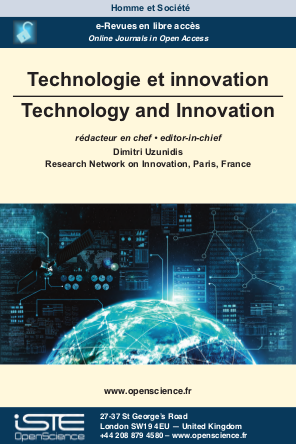

Social Sciences and Humanities > Home > Technology and Innovation > Issue
This issue of TechInn is dedicated to the tools of structural analysis applied to the economics of innovation. It includes six articles. The essential message they carry is that these tools are not only used to draw / visualize relationships between nodes in a network. They also serve as a decision-making aid for companies and public authorities in terms of innovation strategy and policy.
The patent is an early marker of global innovation. Repositories have grown exponentially over the past decade, making it possible to build databases that can hold up to 130 million today. As they are made up of a stack of very different sources and quality, these databases are difficult to use to accurately measure the semantic distance between the concepts of patent families and visualize them in the form of relevant maps. We have selected the DWPI database and the associated processing algorithms to create maps of global innovations and show, through various examples, how experts from large companies use them. These maps make it possible to identify the emergence of innovations and global trends, in order to position the inventions of companies in their competitive environment, which is essential to arbitrate investments, select the most suitable partners and ultimately increase R&D productivity. It is essential to master Technological Intelligence and better understand why companies do not communicate on the subject, in order to maintain a major competitive advantage.
Technological co-occurrence graphs in innovation economics are built using patent data, extracting the technological classes associated with inventions by experts from intellectual property offices. Co-occurrence occurs when the same invention is allocated to several technologies. The last decade has seen the development of many original methods for processing patent data via these co-occurrence graphs. The objective of this article is to identify and illustrate the issues of the innovation economy addressed by technological co-occurrence graphs.
The aim of this article is to propose the structural readings of two indicators of the technological quality of patents: originality and generality. To do so, we transform them into mathematical objects - graphs - and insist on amendments and extensions inspired by this new approach. In the first reading, we start from the original indices and we directly apply a representation in the form of graphs to them. In the second reading, we start from the technological flow matrices and reconstruct the dispersion indices as they were originally conceived. We go even further by proposing other indices of technological quality from these matrices, including one that seems to have a greater scope for assessing this quality.
An influence graph is the representation of a flow structure in the economic dominance theory. We adapt the notion of a maximum spanning tree to the context of influence graphs for a single impulse node. We experiment on international trade flows with this tool in order to calibrate it. We conclude that the selected tree correctly synthesizes the main dependency relationships of the structure despite its very small contribution to the total dependency. Finally, we discuss the adaptation of the tool to the analysis of technological flows.
The aim of this paper is to identify some characteristics of the process of emergence of biomedical engineering technologies using patent data. [GKO 16] use the co-occurrences of technology allocations in patents to describe the phenomena of technology diffusion, which they understand as the ability of one technology to combine with others more frequently over time, so as to diversify its uses. We extend their approach and propose an empirical test to verify the impact of inventiveness and an exploration on the processes of diffusion used by these technologies in three different institutional environments: Europe, the United States and Japan over the period 1980-2015.
Industrial emergence based on total or partial mergers of sectors formerly organized in silos remains a blind spot in industrial economics. The "augmented markets" approach constitutes an alternative to the industrial life cycle and the technological innovation system approaches to provide elements for interpreting strategic movements that characterize significant sectoral dynamics today. In this paper, we propose using the economic dominance theory (EDT) to associate the technology and the sector. The EDT ensures, upstream of any attempt of empirical validation at the "production" and "market" levels, that the technological foundations of sectoral emergence through convergence are indeed present.
In an ever-changing environment, telecom operators need the best technology to meet their business needs. The new generation will improve and create new uses that cannot be satisfied by current technologies. Latency, throughput and reliability, among others, are essential to meet new usage and manufacturing concepts. The continuous evolution of networks goes beyond previous generations of mobile communication. Capabilities include massive system capacity, very high data rates, reliability and availability, very low latency, and much lower cost and power consumption. Network slicing will allow operators to provide dedicated virtual networks with customer-specific features. Distributed Cloud will allow workloads to be placed closer to the edge for better quality of service such as latency, real-time machine learning and artificial intelligence (AI). Analysis will be important in enabling self-optimization and network security. In telecommunications, a Service Level Agreement (SLA) defines a set of specific services adapted to the needs of each customer. Operators will be able to take advantage of the benefits of 5G to satisfy their customers and promote the different 5G value chains in order to develop the future business.

2025
Volume 25- 10
Issue 12024
Volume 24- 9
Issue 12023
Volume 23- 8
Issue 12022
Volume 22- 7
Issue 12021
Volume 21- 6
Issue 12020
Volume 20- 5
Issue 12019
Volume 19- 4
L’innovation agile2018
Volume 18- 3
Issue 42017
Volume 17- 2
Mobility Innovations. Transport, management of flows and territories2016
Volume 16- 1
Issue 1